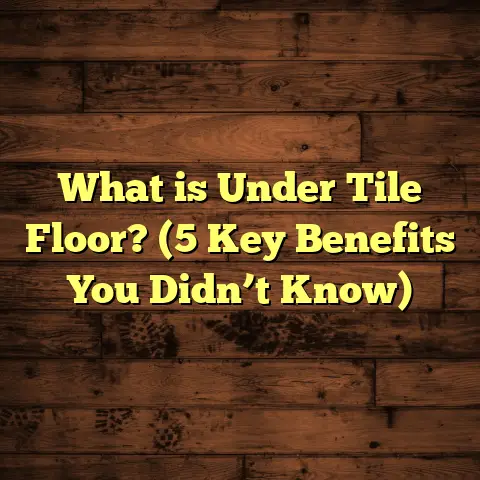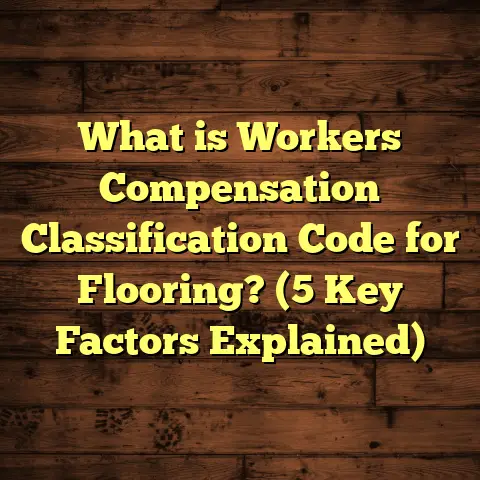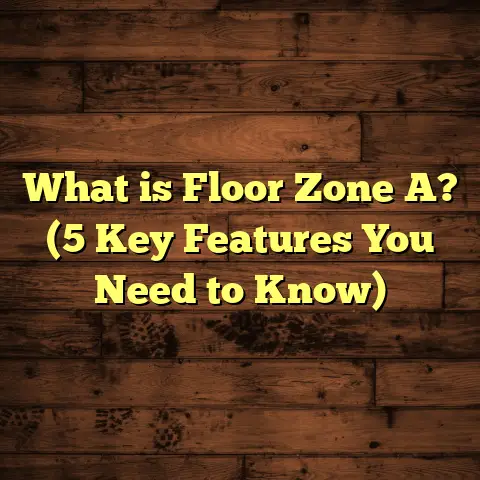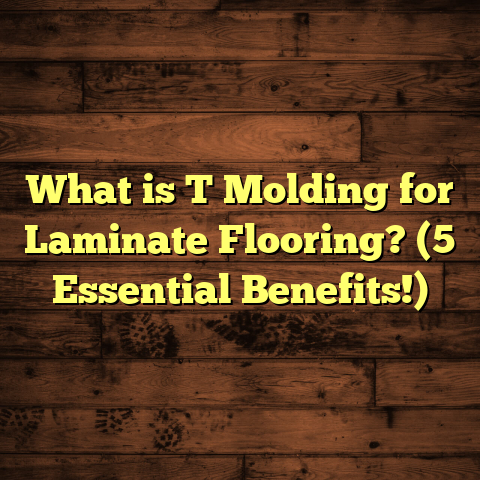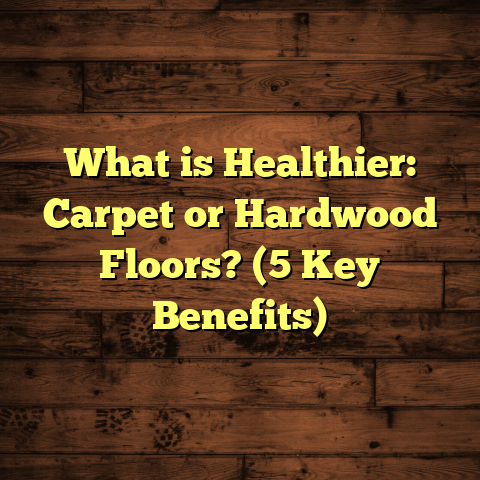What is Bottom Molding of Floor Called? (5 Essential Types)
Have you ever been in a room and noticed that little strip at the bottom of the wall where it meets the floor and wondered what it’s called? Maybe you’ve been staring at it while thinking about redoing your floors or just wanted to know why it’s there and what purpose it serves. It often goes unnoticed, but that small piece can actually make a big difference in the look and durability of your flooring. I’m going to walk you through what that strip is, why it’s important, and the five essential types of bottom molding used in flooring projects.
When I first started out in flooring, I really didn’t pay much attention to moldings. I thought, “It’s just trim, right? How important can it be?” But after installing hundreds of floors, I realized that bottom molding is like the frame around a picture—it finishes the look and protects your investment. Over time, I learned that picking the right molding not only makes your floors look better but also helps them last longer.
So, what exactly is bottom molding? Why do people use it? And what are the different types? Let me break it down for you.
What Is Bottom Molding of Floor?
Bottom molding is a type of trim or finishing strip installed at the base of walls where they meet the floor. Its main job is to cover the gap between the wall and the flooring material. This gap is necessary because most flooring materials expand and contract due to changes in temperature and humidity. Without that gap, floors could buckle or warp.
When you install hardwood, laminate, or even vinyl floors, you leave a small expansion gap around the edges for this reason. But those gaps aren’t exactly beautiful to look at, so bottom molding hides them while also protecting your walls from damage caused by foot traffic, vacuum cleaners, furniture bumps, and other everyday wear and tear.
In my early days as a flooring contractor, I saw many floors that looked unfinished simply because they lacked this finishing detail. That’s when I started paying special attention to bottom moldings — and I discovered just how much they enhance a room’s appearance.
Beyond aesthetics, bottom molding has some practical benefits:
- Hides Expansion Gaps: Floors need room to expand; moldings hide these necessary gaps.
- Protects Walls: Helps prevent scuff marks and damage to drywall or plaster.
- Improves Cleanliness: Stops dirt and dust from accumulating in wall-floor gaps.
- Provides a Finished Look: Makes any flooring installation look professional and complete.
But let me tell you: not all bottom moldings are created equal. There are several types, each serving slightly different purposes and fitting different styles and floor types. Based on my experience, here are the five essential kinds you should know about.
1. Baseboard Molding
Let’s start with the one almost everyone knows: baseboard molding. This is the wide trim you usually see running at the bottom of walls throughout most homes.
What Is Baseboard Molding?
Baseboards are flat or slightly contoured boards that cover the joint between the wall and floor. They’re typically 3 to 6 inches tall but can be taller depending on style preference. The main job of baseboards is to hide the expansion gap between flooring materials like hardwood or laminate and the wall surface.
Why Baseboards Are So Common
I often recommend baseboards because they’re effective and versatile. They add a clean edge to any room and protect walls from accidental kicks and scuffs from vacuum cleaners or furniture legs. When I installed hardwood floors in my own house, choosing baseboards with a bit of height gave the rooms a more elegant look—almost like adding crown molding but at floor level.
Materials Used for Baseboards
Baseboards come in various materials:
- Wood: Traditional choice; can be painted or stained.
- MDF (Medium-Density Fiberboard): Cost-effective, smooth surface suited for painting.
- PVC or Vinyl: Water-resistant options great for bathrooms or basements.
- Metal: Used for modern or industrial looks but less common in residential homes.
Styles and Profiles
Baseboards come in many profiles—from simple flat boards to more decorative ones with grooves or curves. You might have seen “colonial” style baseboards with fancy edges or simple square-edge ones that look modern.
I’ve noticed in higher-end homes that thicker and taller baseboards are often chosen to complement high ceilings and upscale interiors. In contrast, smaller baseboards work well for minimalist designs or smaller rooms where space feels tight.
Installation Tips
Installing baseboards properly requires careful measuring and cutting at corners (usually miter cuts). Nails or adhesive can be used to secure them. I always recommend sealing any gaps with caulk for a flawless finish.
Data Insight
A 2023 survey by the National Wood Flooring Association (NWFA) revealed that approximately 72% of homeowners choose baseboard molding when installing hardwood floors. The average baseboard height selected was 4 inches, which balances style and function well.
My Personal Experience
I recall a project where the client wanted a classic look for their living room with dark hardwood floors. We installed 5-inch tall painted white baseboards that contrasted beautifully with the dark wood grain. It gave the space character without overwhelming it.
2. Quarter Round Molding
Have you ever noticed a small rounded strip near your baseboard? That’s quarter round molding—a subtle finishing touch that’s often overlooked but very useful.
What Is Quarter Round Molding?
Quarter round molding is a small, quarter-circle shaped trim piece used to cover narrow gaps between the floor and baseboard or wall. It’s usually about 3/4 inch wide and tall.
When Should You Use Quarter Round?
In my experience, quarter round molding is a go-to for quick installations where full baseboards aren’t an option or already exist but need finishing touches.
Materials Available
Quarter rounds are typically made from:
- Wood: Easy to paint or stain.
- MDF: Smooth for painting; budget-friendly.
- PVC/Vinyl: Moisture resistant for wet areas.
Installation Notes
They are nailed or glued into place at the floor level, often painted to match the baseboards. Because they’re curved, they add softness to the room’s edges without making walls feel heavy.
Unique Insights from My Work
Once, I was tasked with finishing a recently installed laminate floor in a rental property. The landlord wanted something quick but durable. Using quarter round molding saved time and provided a clean finish without replacing existing baseboards.
3. Shoe Molding
Shoe molding is similar to quarter round but with slight differences that make it ideal for certain situations.
What Is Shoe Molding?
Shoe molding is a narrow strip of wood or MDF with a more elongated profile compared to quarter round. It’s slightly taller and thinner than quarter round but serves a similar purpose—to cover expansion gaps between floors and baseboards.
Why Choose Shoe Molding?
I often recommend shoe molding when floors are uneven or when larger gaps need covering. Its taller profile offers better coverage while maintaining a sleek appearance.
One project comes to mind where an older home had uneven hardwood floors; shoe molding was perfect to hide gaps without needing major floor adjustments.
Material Choices
Most shoe moldings are made from wood or MDF. Wood shoe molding painted white looks great in traditional homes because it blends well with standard baseboards.
Installation Tips
Like quarter rounds, shoe molds are nailed or glued at floor level. They’re often used alongside baseboards rather than replacing them.
Case Study
In renovating a 1940s Craftsman-style home, shoe molding helped conceal expansion gaps on original hardwood floors while preserving the historic look of thick baseboards intact above it.
4. T-Molding
T-molding isn’t exactly bottom molding along walls but plays an important role in flooring finishes—especially at doorways.
What Is T-Molding?
T-molding looks like an uppercase “T” from the side profile. It’s primarily used as a transition piece where two different types of flooring meet—like hardwood next to tile or laminate next to carpet.
When Do You Need T-Molding?
I include this here because many people confuse T-molding with bottom moldings due to its proximity near floors. Though not used along walls, it’s vital for finishing floor edges between rooms.
For example:
- Hardwood floor meets tile at kitchen entrance.
- Laminate transitions into carpeted hallway.
- Two types of wood flooring with slight height difference meet at room boundary.
T-molding bridges these surfaces smoothly while covering expansion gaps between them.
Materials & Styles
T-moldings are usually made of wood, laminate, or vinyl matching adjacent floor materials for a seamless look.
My Experience Using T-Molding
I installed T-molding in several open-concept homes where kitchen tile met hardwood living areas. It created smooth transitions without tripping hazards and prevented damage at edges—a small detail but essential for safety.
5. Reducer Molding
Reducer molding is similar in function to T-molding but designed specifically for height differences between two adjacent flooring surfaces.
What Is Reducer Molding?
Reducer molding slopes gently between two floors where one is higher than the other—like hardwood next to vinyl or laminate that sits lower.
Practical Uses
Reducer moldings protect edges from chipping and make steps between floors safer by eliminating sharp height changes.
If you’ve ever tripped over uneven flooring edges or seen worn-out floor edges where materials meet, lack of proper reducers was probably why.
Why It Matters
In many renovation projects where old flooring meets new materials, reducers provide a professional finish and long-term durability.
Data From Industry Reports
Flooring suppliers report that floors installed with proper reducer moldings show 25–30% less wear at transition points over five years compared to those without reducers.
Personal Story
Once I worked on a condo where vinyl plank flooring was installed next to existing hardwood stairs. We installed reducer molding on each stair edge—the client appreciated how safe and clean it looked afterward.
A Closer Look: Why Bottom Moldings Matter More Than You Think
You might be wondering if all this talk about bottom moldings is just about aesthetics. From my hands-on experience installing floors in hundreds of homes over the years, these little details do much more than make your room look nice.
Here’s why bottom moldings deserve serious attention:
- Prevent Floor Damage: Expansion gaps let floors move naturally without buckling or cracking.
- Wall Protection: Moldings shield walls from scuffs caused by furniture, vacuum cleaners, pets, and foot traffic.
- Cleanliness: Moldings stop dust, dirt, and debris from collecting in unsightly wall-floor gaps.
- Professional Finish: Proper moldings make any floor project look complete—without them, floors feel unfinished.
- Safety: Transition moldings like T-molding and reducers reduce trip hazards where different floor materials meet.
When I helped renovate my parents’ home, we replaced old carpet with engineered hardwood. Adding baseboards plus quarter round molding not only improved appearance but made maintenance easier since no dirt could get trapped under loose edges.
How to Choose Bottom Moldings For Your Floor: A Practical Guide
Choosing bottom moldings can seem confusing since there are so many options out there. Based on my experience, here’s what you should consider:
- Floor Type
Different flooring materials require different moldings:
- Hardwood floors typically pair well with baseboards plus quarter round or shoe molding.
- Laminate floors usually use baseboards combined with quarter rounds.
- Vinyl flooring benefits from PVC or vinyl-based moldings due to moisture resistance.
- Tile often needs reducer or T-moldings if transitioning to other materials.
- Carpet generally only uses baseboards since carpet covers edges itself.
- Room Function
Rooms exposed to moisture (bathrooms/kitchens) need moisture-resistant moldings like PVC or vinyl rather than traditional wood.
- Style Preference
Are you going for traditional warmth? Tall wooden baseboards stained or painted might work best. Prefer modern minimalism? Slimmer moldings with clean lines fit better.
- Budget
Wood moldings cost more than MDF or PVC options but offer better durability and finish quality if cared for properly.
- Height Differences
If floors meet at different heights (like tile next to wood), reducer or T-moldings are necessary for safety and finish quality.
Here’s a quick reference table I often share with clients:
| Flooring Type | Recommended Bottom Molding | Notes |
|---|---|---|
| Hardwood | Baseboard + Quarter Round or Shoe | Classic look; hides gaps well |
| Laminate | Baseboard + Quarter Round | Easy installation |
| Vinyl | Baseboard (PVC preferred) | Moisture resistant |
| Tile | Baseboard + Reducer or T-molding | Handles height differences |
| Carpet | Baseboard only | Carpet covers edges |
Stories From My Flooring Projects: Real-Life Examples That Show Why Moldings Matter
Over the years, I’ve seen how small decisions about moldings affect overall satisfaction with flooring projects:
- In one upscale condo renovation, we used wide white baseboards paired with shoe molding on dark oak floors. The client loved how polished their living room looked during showings.
- In an older craftsman house restoration, shoe molding helped hide uneven floor edges while preserving original tall baseboards—maintaining historic charm.
- For a rental property owner who wanted low-cost solutions, MDF baseboards paired with quarter rounds gave solid looks on laminate floors without breaking the bank.
- In several bathrooms and basements prone to moisture exposure, PVC moldings prevented warping issues common with wood trims.
- For commercial offices transitioning between carpeted meeting rooms and tiled hallways, T-moldings ensured safe transitions while keeping designs sleek.
These examples prove that choosing the right bottom molding can make your floors look better, last longer, save money on repairs—and even help sell homes faster!
Maintenance Tips for Bottom Moldings
Once your floor moldings are installed, keeping them looking great isn’t difficult but requires some care:
- Cleaning: Regular dusting and wiping prevent dirt buildup around edges.
- Touch-ups: Painted wood moldings may chip over time; keep some paint handy for touch-ups.
- Caulk Gaps: Check for shrinking gaps around moldings seasonally; re-caulk if needed.
- Avoid Water Damage: Use moisture-resistant moldings in wet areas; wipe spills immediately.
I always advise clients to include molding upkeep in their regular home maintenance plans—it’s easy but makes a big difference over years.
Frequently Asked Questions About Bottom Moldings
Q: Can I install bottom molding myself?
A: Yes! With basic tools like a miter saw and nail gun or adhesive, most DIYers can handle installing baseboards, quarter rounds, or shoe molds themselves if they follow measurements carefully.
Q: What color should my bottom molding be?
A: White painted moldings are classic and popular because they contrast nicely against most floor colors and walls. Natural wood stains work well in rustic or traditional settings.
Q: How much does bottom molding cost?
A: Costs vary by material; MDF baseboards average $1–$3 per linear foot; wood can range $3–$8 per linear foot; PVC options fall somewhere in between depending on quality.
Q: Do I need both baseboard and quarter round?
A: Not always; if your existing baseboard is tall enough to cover expansion gaps fully, you might skip quarter round. But if gaps remain visible or floors are uneven, adding quarter round is common practice.
Wrapping Up My Thoughts on Bottom Moldings
Bottom moldings might seem like minor details but play crucial roles in both protecting your floors and completing their look. They’re functional pieces hiding expansion gaps while adding style and protection against damage.
From my personal experience installing hundreds of floors across different styles and budgets, choosing the right type—whether baseboard, quarter round, shoe molding, T-molding, or reducer—makes all the difference in satisfaction with your finished floor.
So next time you notice that strip along your wall-floor joint, appreciate how much work goes into making it both beautiful and practical! And if you’re planning new floors soon, don’t skip talking about moldings—they’re one of those small things that can turn good into great.
If you want advice tailored to your specific flooring project or help choosing materials within your budget and style preferences, just ask—I’m here to help!
